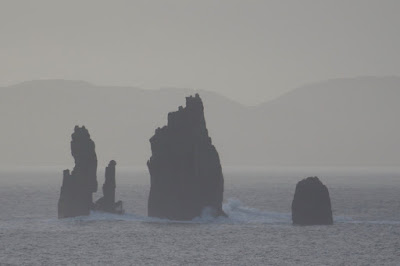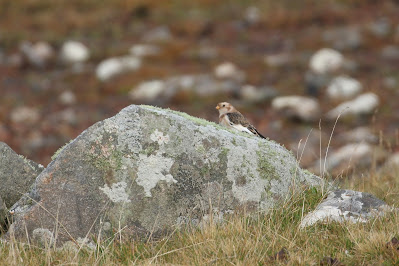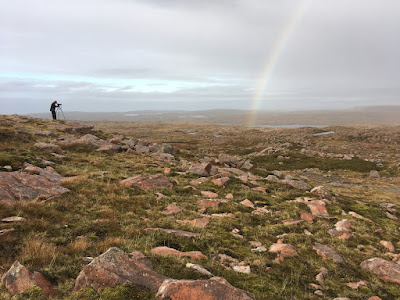I summed up day 6 of our Shetland trip a a single word tweet at the time: 'NEXT'. It was a bit harsh in retrospect but only a bit - the birding highlight, rarity wise, was a soggy Common Rosefinch at Hamnavoe. In fact the most memorable moments of the day had precious little to do with birds and more to do with the multi-course meals we ate whilst waiting for the rain to stop and, when we did finally get out, another near disaster with a camera lens - not mine this time but Jono's.
 |
| Rock Pipit, Eshaness |
 |
| Eshaness |
We were photographing a Tystie in Bridgend harbour and were both making our way down a slipway towards it to get a lower angle shot. Aware of the treacherous possibilities, and blessed with the dynamic risk assessment capabilities which any self-respecting local government officer should possess, I opened my mouth to voice the potential skid hazard at which point Jono went into a graceful but seemingly never-ending slide towards the cruel sea.
 |
| Eshaness |
 |
| Eshaness |
Amazingly, he was able to lay down his monster 500mm lens with all the skill of a Crown Green bowler gently rolling a bowl down within inches of the puck. So the camera was safe but the photographer was not and his slide continued deep into the brine. Fortunately he hit the point where buoyancy triumphed over gravity and the slide was arrested before we had to reach for the life-ring. Even more amazingly, there was a public toilet by the slipway enabling him to clean up there and then - but it tells you everything you need to know about day 6 that the incident was about the only thing worth writing about. (I'm so far behind with posts you can triangulate the veracity of this account with those of other witnesses/participants
here and
here).
 |
| Orca, Eshaness |
 |
| Orca, Eshaness |
Day 7 on other hand....started with a long schlep out to the wild coast at Eshaness, where the dramatic cliffs and stacks always make the trip worthwhile, regardless of whether or not the American waders of our dreams are strutting around the close cropped sward of the headland. Not long after we arrived a bellow from Howard had us running to his position by the lighthouse: his sharp eyes had picked out not a wader, but a pod of Orca. Over the next hour we enjoyed great scope views as they tracked slowly north, lingering long enough for us to get news out and enable a lucky few to successfully twitch them.
 |
| 6 of the pod of 8 in this shot |
 |
| Amazing creatures! |
A Sooty Shearwater cruising past the whales and a Snow Bunting disturbed during a subsequent lochside stroll capped a memorable few hours at Eshaness and we invited the proprietor of Bradders Birding Tours to spin the wheel and decide on our next stop. This took us to the quiet surroundings of Ronas Voe where we enjoyed views of Eiders, a Common Scoter, a Long-tailed Duck and a Black-throated Diver.
 |
| The big bull (right) with tall triangular dorsal fin |
 |
| Snow Bunting, Eshaness |
Having lulled us into a false sense of security with this gentle bimbling, Bradders then hit us with his cunning plan for the rest of the day: to march us up to the top of Ronas Hill, and then march us down again. The purpose of this late afternoon excursion was to look for Snowy Owl, a species which had occasionally been seen in this area earlier in the year.
 |
| Bradders strides out at Eshaness |
 |
| Bradders strides out some more at Eshaness |
Suffice to say we were unsuccessful, foiled ultimately by thick fog which closed around us having yomped a good couple of clicks into the starkly beautiful wilderness. But it was worth it, both to work off the foody excesses of the previous day and to appreciate the unique landscape of the area.
 |
| Jono looking for Hedwig in a rainbow on Ronas Hill |




















































